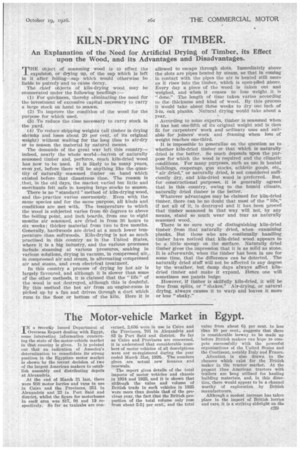KILN-DRYING OF TIMBER.
Page 69

If you've noticed an error in this article please click here to report it so we can fix it.
An Explanation of the Need for Artificial Drying of Timber, its Effect upon the Wood, and its Advantages and Disadvantages.
THE object of seasoning wood is to effect the expulsion, or drying up, of the sap which is left in it after felling—sap which would otherwise be liable to putrefy and to cause decay.
The chief. objects of kiln-drying wood may be enumerated under the following headings:— (1) For quickness, thereby eliminating the need for the investment of excessive capital necessary to carry a large stock on hand to season.
(2) To improve the condition of the wood for the purpose for which used.
(3) TO reduce the time necessary to carry stock in the yard.
. (4) To reduce shipping weights (all timber in drying shrinks and loses about 20 per cent, of its original weight) without waiting for the long time to air-dry or to season the material by natural means.
The demands of the great war left this country— indeed, nearly the whole world—barren of naturally seasoned timber and, perforce, much kiln-dried wood has now to be used. It is likely to be many years, even yet, before there will be anything like the quantity of naturally seasoned timber on hand which existed before that disastrous time. The reason is that, in the old days, the market varied but little and merchants felt safe in keeping large stocks to season.
There is no "standard "method of kiln-drying wood, and the. practice varies enormotsly. Even with the same species and for the same purpose, all kinds and conditions are met with. The temperature to which the wood is subjected varies from 60 degrees to above the boiling point, and inch boards, from one to eight months air seasoned, are ;fried in from 38 hours to six weeks; thicker material from two to five months. Generally, hardwoods are dried at a much lower temperature than softwoods. Kiln-drying is not so much practised in this country as in the United States, where it is a big industry, and the various processes include steaming at various pressures, soaking in various solutions, drying in vacuum, in compressed air, in compressed air and steam, in alternating compressed air and steam, and even electrical treatment.
In this country a process of drying by hot air is largely favoured, and although it is slower than some of the other methods, it is claimed that the "life" of the wood is not destroyed, although this is doubtful. By this method the hot air from an-engine-room is picked up by a fan and driven through a duct which runs to the floor or bottom of the kiln. Here it is allowed to escape through slots. Immediately above the slots are pipes heated by steam, so that in coming in contact with the pipes the air is heated still more as it rises into the timber, which is open-piled above. Every day a piece of the wood is taken out and weighed, and when it ceases to lose weight it is "done." The length of time taken varies according to the thickness and kind of wood. By this process it would take about three weeks to dry one inch of 3-in, oak planks. Natural drying would take about a year, • According tO some experts, timber is seasoned when it has lost one-fifth of its original weight and is then fit for carpenters work and' ordinary uses and suitable for joiners' work and framing when loss of weight reaches one-third.
It is impossible to generalize on the question as to whether kiln-dried timber or that which is naturally dried is the better. So much depends upon the purpose for which the wood is required and the climatic conditions. For many purposes, such as use in heated buildings, cooperage, gun stocks, athletic goods, etc., "air dried," or naturally dried, is not considered sufficiently dry, and kiln-dried wood is preferred. But, for constructional purposes, it is generally agreed that in this country, owing to the humid climate, naturally dried timber is the better.
Whatever advantages may be claimed for kiln-dried timber, there can be no doubt that most of the "life," if not all of it, is destroyed and it has been proved that timber seasoned in that way will not, by any means, stand so much wear and tear as naturally seasoned wood.
There is no sure way of distinguishing kiln-dried timber from that naturally dried, when examining planks. But those who are continually handling timber have noticed that kiln-dried wood appears to be a little spongy on the surface. Naturally dried timber gives the impression that it is as solid as stone. It is afterwards; when the timber has been in use for some time, that the difference can be detected. The naturally dried stuff will not be affected to any degree by the weather, but damp days always affect kilndried timber and make it expand. Hence one will sometimes see panels bulge.
However, if timber is skilfully kiln-dried, it will be free from splits, or "shakes." Air-drying, or natural drying, always causes it to warp and leaves it more or less "shaky."




























































































































